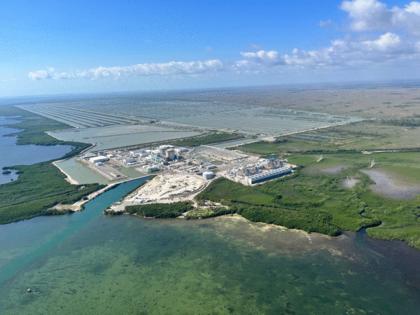Florida power company has a deadline to clean up salty pollution under Turkey Point. It won't make it
Published in Science & Technology News
MIAMI — A giant plume of super salty water has been lurking underneath the Turkey Point power plant for years, tainting the surrounding groundwater along the coast of south Miami-Dade County.
Florida Power & Light, which has operated the plant’s twin nuclear reactors for more than a half-century, has been on a 10-year timeline to clean up the pollution. At the halfway point, it’s now clear that FPL is not going to make that deadline.
Miami-Dade County is now pushing the utility to change up its plan of attack on what is known as a “hypersaline plume” produced by the sprawling network of cooling canals created to cool the reactors but undetected for decades.
By the time regulators and water managers found it, the plume had spread far outside the boundaries of Turkey Point. It spread westward, toward South Florida’s drinking water supply. The salty plume never got close enough to compromise any municipal freshwater wells, but it posed a potential continuing risk.
For the last five years, annual reports show FPL has had some success cleaning up the saltwater, especially in the shallower parts of the underground freshwater aquifer. In the middle and lower depths, however, the boundaries of the plume are still far outside FPL’s property line. In many spots, the line has barely budged.
Miami-Dade County wants the utility to expand its effort, which so far has consisted of slurping up the dense, salty water with a dozen wells and pumping fresher, less salty water underground to the west of the plume to push it back east.
Miami-Dade and FPL analyzed more than a dozen options to beef up the utility’s saltwater pumping abilities, including the possibility of installing horizontal wells that can reach even further into the deeper end of the plume to sip up the salt water. That might work, but not in time to meet the current deadline.
“However, FPL’s assessment of these new alternatives indicates that none of them could completely retract the hypersaline plume back to FPL’s property lines by 2028 or even 2033,” a 2024 consultant report for Miami-Dade found.
For now, the ball is in FPL’s court. The utility will soon deliver a plan to the county laying out how it plans to do better at completely cleaning up the plume — a goal that it argued from the beginning was unrealistic under the original 10-year deadline.
Still, FPL has touted its progress at stopping the spread of the plume and pulling back the boundary at the shallowest parts.
“Over a six-year period, the well system has removed more than 36 billion gallons of hypersaline groundwater, which is a significant reduction,” FPL spokesperson Bill Orlove said in a statement to the Miami Herald.
Wilbur Mayorga, chief of the county’s environmental management division, said it might be impossible to predict the exact year the plume will be completely gone, even with FPL’s best efforts, but said Miami-Dade is committed to making sure it happens.
“At the end of the day, it has to do the job. If it doesn’t, I’ll require another modification,” he said. “We are working very hard to ensure the plume is contained and retracted.”
The news that the clean-up won’t be done in ten years has some environmentalists concerned that the Turkey Point cooling canals — the source of the salt pollution — have outlived their lifespan, despite the fact the nuclear plant was just given the OK from federal regulators to keep operating until the 2050s.
Built in 1972 along the then-isolated coast of southern Biscayne Bay, Turkey Point is on track to be the oldest operating nuclear plant in the nation, with approval to run both its reactors until 2052 and 2053 recently granted by the Nuclear Regulatory Commission.
Rachel Silverstein, head of Miami Waterkeeper, challenged the re-licensing in court over the groundwater pollution issue, as well as an argument that the government wasn’t properly considering the risk of sea level rise when it decided to allow Turkey Point to keep operating for another 30 years.
The challenge succeeded, at least in part; NRC asked FPL to do more research on its environmental risks before once again approving the license last fall. But Silverstein said she still worries that regulators aren’t doing enough to force FPL to clean up the saline plume or prepare for climate change.
“FPL has been relying on this remediation plan to push through new permits and licenses for years. But now, halfway through the 10-year timeline, we know it’s not going to meet its targets. We’d like to know how this pollution is going to get addressed, especially before the NRC extends its license to operate until 2052,” she said.
©2025 Miami Herald. Visit at miamiherald.com. Distributed by Tribune Content Agency, LLC.







Comments